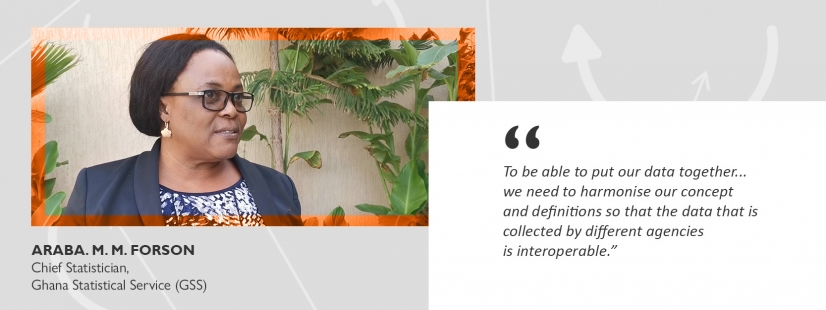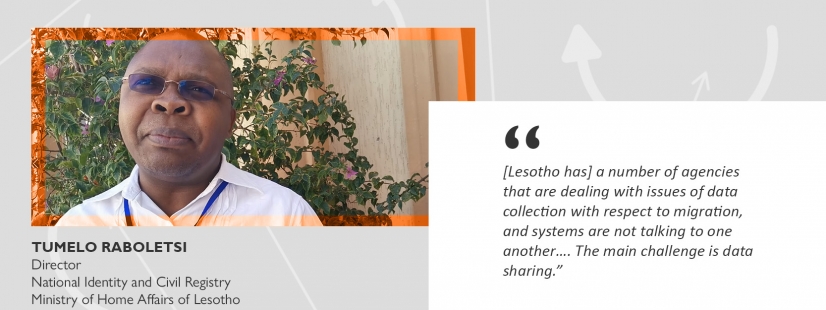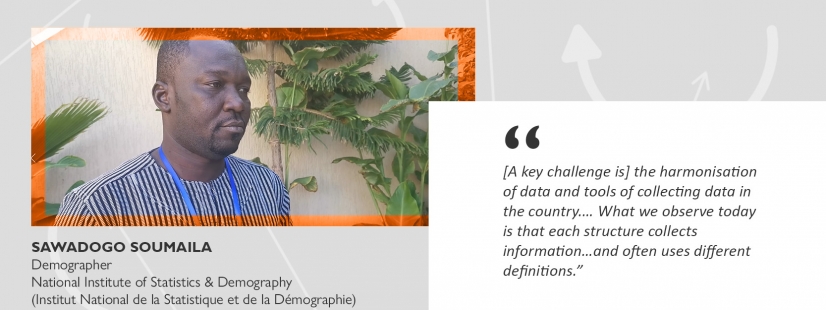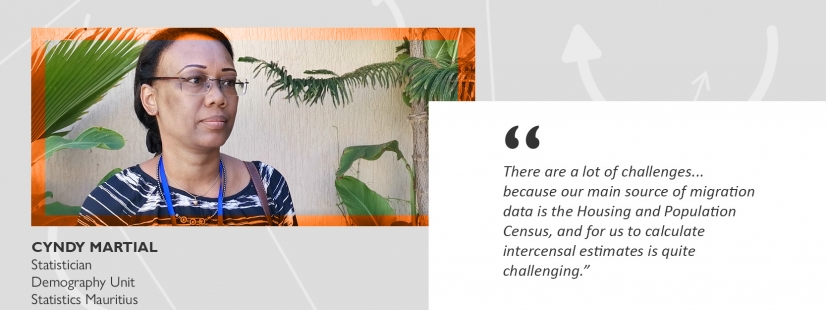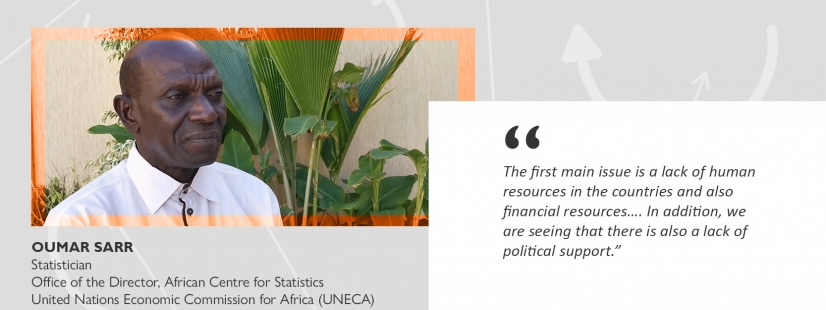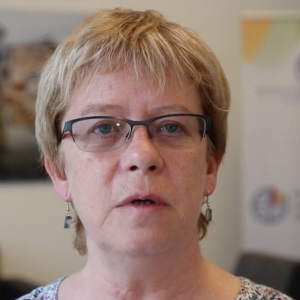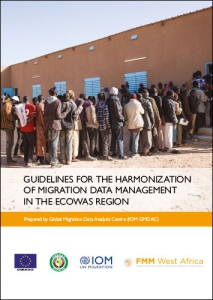GHANA: Harnessing new technologies
Harmonisation of migration data can be a major challenge in Ghana. In particular, it can be difficult to standardise concepts, definitions and methods of collecting migration data.
Coordination between agencies that collect and analyse migration statistics can also be a challenge, and Ms. Forson stated greater collaboration between these was needed. This could support GSS as it uses data produced by various agencies to develop comprehensive statistics on migrants that can be used by policymakers to improve the well-being of both migrant and nationals.
The GSS has been exploring innovative ways to improve migration statistics, working with Flowminder and Vodafone to make use of big data, including satellite imagery, to this end. Ms. Forson stated the GSS planned to use these and “other innovations to make sure we take advantage of opportunities that we have with advancements in technology to provide for the needs of our people, so that nobody is left behind and we have the Africa that we want”. Moving forward, the GSS also aims to improve coordination between agencies, engage more with political leaders to prioritise investment into the production of statistics, in particular disaggregated statistics that improve service delivery for migrants in Ghana.
Find key migration statistics for Ghana here.
Learn more about Ghana’s migration governance.
ZAMBIA: Boosting coordination and automation
In Zambia, migration data are collected from diverse actors and sources, including for example the Census of Population and Housing, various household surveys, and records from several government departments.
The Central Statistical Office has been deploying more up to date technology and increasing levels of automation in its processes, to boost efficiency and reduce costs. For example, it has started using tablets in its regular data collection and has begun automatically tracking exit movements of Zambian citizens from the country so that it is not necessary for them to fill out exit cards. Nevertheless, Mr. Sinyenga stated there is still room for innovation in migration statistics.
Find key migration statistics for Zambia here.
LESOTHO: Using technology to share data more easily
Migration data in Lesotho is held in several systems that are owned by different government actors and that tend not to be linked.
Meanwhile, the Ministry of Home Affairs has been working towards interoperability of systems through a specialised data platform. More generally, Lesotho has also made efforts to move away from paper-based migration data collection and is increasingly using ICT to provide more accurate statistics on migration.
There are also specific migration data gaps which need which require more data collection and collaboration. For example, information on irregular migrants, particularly those migrating from Lesotho to South Africa, is difficult to find and it is an ongoing challenge to monitor these movements. Mr. Raboletsi stated there was a need to engage with counterparts in South Africa to improve data collection efforts on these irregular migrants who often remain invisible.
Find key migration statistics for Lesotho here.
Learn more about Lesotho’s migration governance.
BURKINA FASO: Data harmonisation and technology
In Burkina Faso, as migration data tools do not always use comparable methodologies, work is underway with IOM to improve the harmonisation of data and tools of collecting data. Further, there are specific data gaps in the country. For example, there has not been a specific survey on migration since 1990, and administrative data on migration is currently under exploited.
Nevertheless, there have been key strides made in migration data. The upcoming fifth population register will include a specialised migration module, operationalised with help from IOM. Further, the National Institute of Statistics & Demography will use smartphones to collect information, to accelerate data collection.
One important strategic focus today is on improving migration data collection and management, specifically to support Burkina Faso’s National Migration Strategy of 2017. To date, however, resource mobilisation has been a major obstacle towards this, and more financing and technology are needed to improve migration data.
Find key migration statistics for Burkina Faso here.
REPUBLIC OF MAURITIUS: Data analysis, diversifying sources
In Mauritius, the narrow use of just a few migration data sources can be a challenge for practitioners. The country’s key data source remains its census, and it is more difficult to generate different types of analysis using diverse sources.
Ms. Martial stated the country’s newly developed Migration & Development Policy could help improve migration data. The Policy will be linked to an action plan which will involve different government agencies and actors, including the Passport and Immigration Office, and children, labour, education and other ministries. As the action plan will bring together migration data stakeholders, this could help improve national data collection systems on migration.
Find key migration statistics for Mauritius here.
Learn more about Mauritius’ migration governance.
UNITED NATIONS ECONOMIC COMMISSION FOR AFRICA (UNECA): Resources and political priority, innovation, capacity building
Across the African continent, resource constraints and lack of buy-in are key issues for migration data capacity building. Mr. Sarr stated that while Heads of State of African Union member states adopted the decision to allocate 0.15% of national budgets to statistical activities, to date countries had not yet put this into practice.
For many countries, basic statistical sources on migration data are lacking. Mr. Sarr stated “some African countries… are still lagging behind [with] organising population and housing censuses. Some are staying 40 years without any such census… and now we are developing a programme to assist countries and to advocate for the organisation of a population and housing census during this round of 2020”.
In response to migration data challenges in the region, UNECA has developed a comprehensive programme to support statistical capacity building in the region. This has included organising workshops focusing on improving civil registration and vital statistics, developing a programme to help mainstream gender into daily statistical work and offering advice on how to develop national statistical strategies. In addition to this, UNECA is helping National Statistical Offices (NSOs) to coordinate with mapping agencies to integrate geoinformation into statistical systems.
Find key migration statistics for Africa here.
What next?
In 2018, UN Member States agreed on a set of common goals in managing international migration, through the Global Compact for Safe, Orderly and Regular Migration (GCM). Objective 1 of the GCM calls to “collect and utilize accurate and disaggregated data as a basis for evidence-based policies” and encourages migration data capacity building initiatives to achieve this. The Sustainable Development Goals (SDGs), adopted in 2015, have also helped place a global spotlight on migration data, as many SDG indicators require improved migration data as well as disaggregation by migratory status.
These two global processes have opened up significant migration data needs and are key opportunities to improve migration data around the world through greater effort and investment in capacity building activities. The interviews above suggest that we need to build on existing innovative practices in different countries, share these experiences more widely, and work with African experts to move migration data capacity building efforts forward.
Disclaimer: The opinions expressed in this blog are those of the authors and do not necessarily reflect the views of the International Organization for Migration (IOM) or the United Nations. Any designations employed and the presentation of material throughout the blog do not imply the expression of any opinion whatsoever on the part of IOM concerning the legal status of any country, territory, city or area, or of its authorities, or concerning its frontiers and boundaries.
With thanks to Eric Mazango, Communications Officer (Special Liaison Unit to the AU, UNECA and IGAD), IOM Addis Ababa, for recording the interviews.


